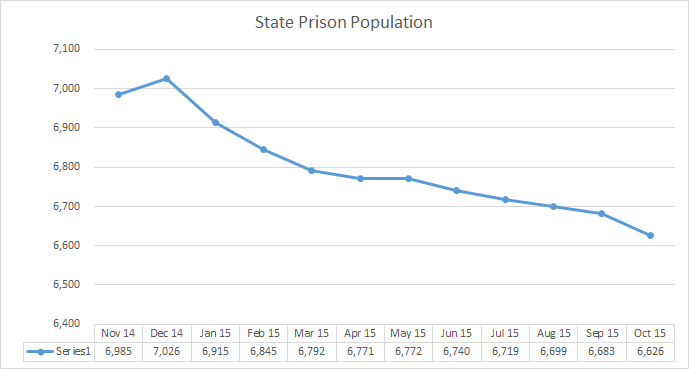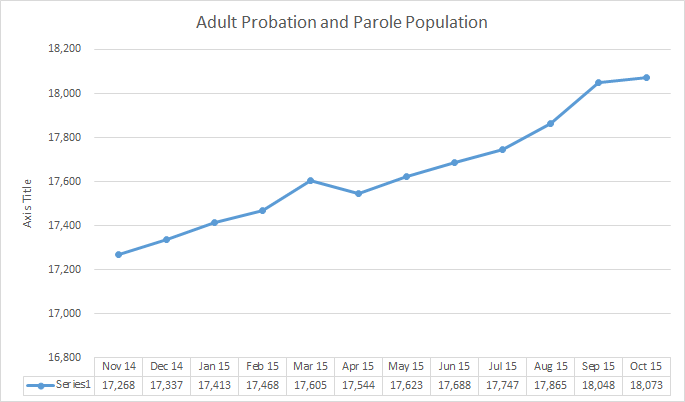Fiscal Highlights - November 2015
|
Corrections' Populations Status November 2016 -
Gary R. Syphus ( The main cost drivers of the Department of Corrections are the (1) prison population and (2) adult probation and parole (AP and P) populations, and related resources to manage the populations. These populations require significant resources in the form of correctional officers, housing, food, transportation, treatment, medical care, and so forth. In general, the greater these populations, the more resources that need to be expended, and conversely, the smaller the population, the fewer resources that need to be used. The Legislature should consider important questions when determining the budget to manage these populations such as, "What is the status of current prison population and what is the projected growth, if any?" In addition, the Legislature may ask, "What is the right balance of resources to manage and treat these populations?" Below are the two main populations - the combined state inmate population inside the Draper and Gunnison prison and county jails, and the state offenders on probation and parole within the community. The prison population shows a significant decrease over the last 12 months - putting less pressure on resources used to manage this population. Interestingly, this decrease developed before the implementation of the policy change related to the Justice Reinvestment Initiative (JRI). The Department does not predict any new prison growth but expects additional AP and P growth for the new fiscal year and should have updated projections for the 2016 General Session.  Inverse from what the prison population shows, the Adult Probation and Parole Population grew over the last 12 months - putting additional pressure on AP and P officers and related resources that manage these populations.  Presumably with this trend and an additional change in policy as a result of the Justice Reinvestment Initiative, this may be a trend for the short-term and long-term. The Executive Offices and Criminal Justice Appropriations Subcommittee began examining these populations during interim meetings and identified some potential resources that could be reallocated to better manage both of these populations and will require more attention during the General Session in order to best optimize resources against these cost drivers. |
A Look at the Change in Utah's 2015 Unemployment Rate Compared to Other States - Thomas E. Young The unemployment rate in Utah is one of the lowest in the country at 3.6%. Based on the most ...Corrections' Populations Status November 2016 - Gary R. Syphus The main cost drivers of the Department of Corrections are the (1) prison population and (2) adult ...Division of Fleet Operations General Fund Borrowing - Brian Wikle The Division of Fleet Operations was established as an internal service fund (ISF) in FY 1997. ...Fall Enrollment on the Upswing in Higher Education - Spencer C. Pratt The Utah System of Higher Education experienced an increase of 2,775 Budget-Related FTE students fo...Medicaid Costs Projected to Rise - Russell T. Frandsen Medicaid - What is Included in Consensus for Mandatory Costs? The Medicaid forecast te...Performance Note Improvements in Six Easy Steps - Steven M. Allred Most of us have become familiar with performance notes since a rule change in the 2011 General Sess...Phragmites Control on the Great Salt Lake - Ivan D. Djambov The Division of Forestry, Fire, and State Lands is continuing to work on phragmites control on sove...Taking the Game Out of Salary and Related Benefit Budget Estimates - Stephen C. Jardine Prior to 2012 the possibility existed that an agency could estimate the salary and related benefi...USTAR's Proposed Budget Changes - Clare Tobin Lence The Utah Science Technology and Research (USTAR) Initiative has undergone budget reorganizations ... |
Reports/Archive | Budget Process | Office Background | Who's Who | Organization Chart
Office of the Legislative
Fiscal Analyst
House Building, Suite W310
Salt Lake City, UT 84114
Phone (801) 538-1034 Fax (801) 538-1692